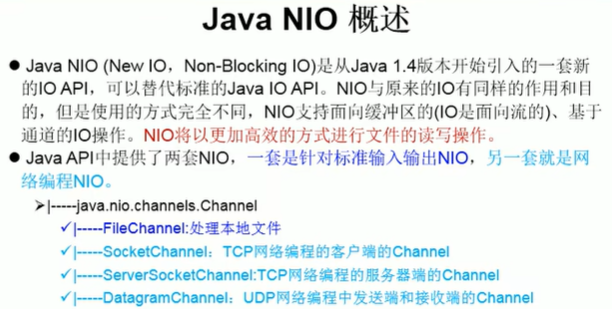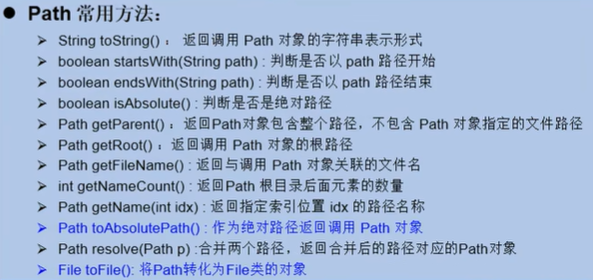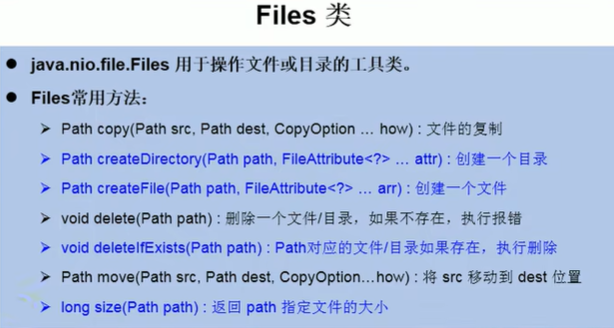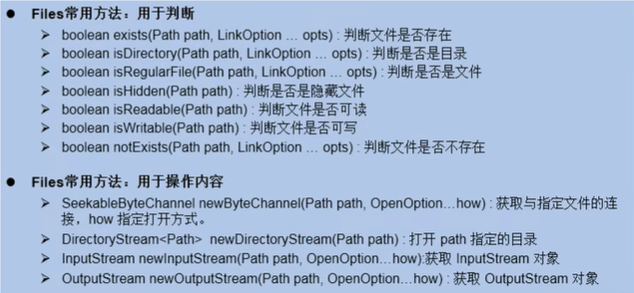1. The principle of IO flow
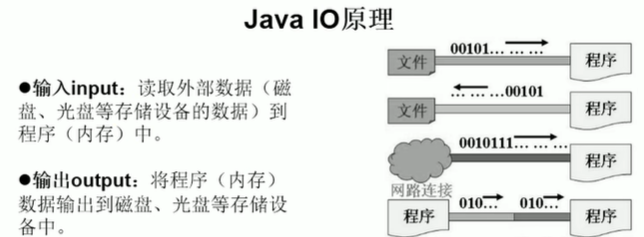
2. Classification of IO streams
According to the operation data unit division: byte stream, character stream
Divided according to the flow direction of data: input stream, output stream
According to the role of flow: node flow, processing flow
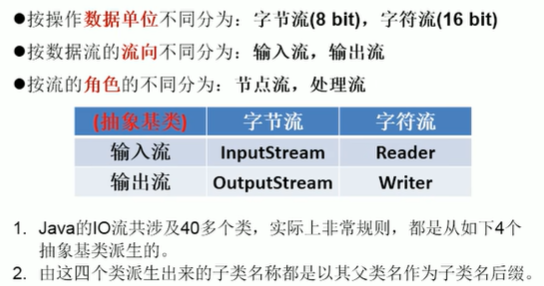
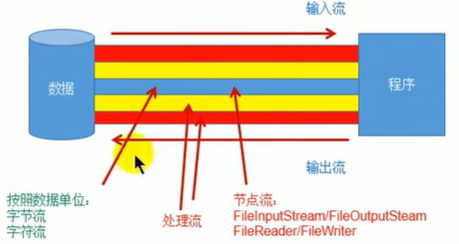
3. Architecture of IO stream
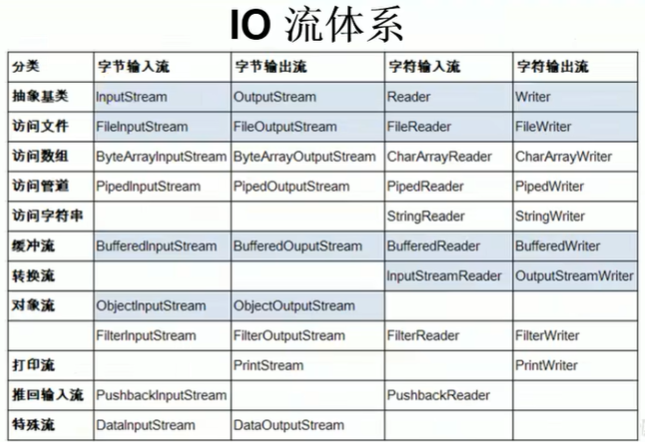
1. Read and write operations of character streams
1.1 Reading files
//读取文件操作
FileReader fr = null;
try {
// 实例化File类的对象,指明要操作的文件
File file = new File("1.txt");
// 提供具体的流
fr = new FileReader(file);
// read():返回读入的一个字符,如果达到文件末尾,返回-1
int read;
do {
read = fr.read();
System.out.println((char) read);
} while (read != -1);
} catch (IOException e) {
throw new RuntimeException(e);
} finally {
// 流的关闭
if (fr != null) {
try {
fr.close();
} catch (IOException e) {
throw new RuntimeException(e);
}
}
}Explanation:
1. The understanding of read(): Return a character that was read. If it reaches the end of the file, return -1
2. Exception handling: In order to ensure that the stream resource can be closed. Need to use try-catch-finally to process
3. The read-in file must exist, otherwise FiLeNotFoundException will be reported.
char[] cbuf = new char[5];
//read(char[] cbuf): 返回每次读入cbuf数组中的字符个数。如果达到文件末尾,返回-1
int len;
while ((len = fr.read(cbuf)) != -1) {
// 错误的写法:最后一次的长度不足字符数组的长度时,会有遗留数据
/* for (int i = 0; i < cbuf.length; i++) {
System.out.println(cbuf[i]);
}*/
for (int i = 0; i < len; i++) {
System.out.println(cbuf[i]);
}
// 错误的写法二:和上面原理一样
// String str = new String(cbuf);
String str = new String(cbuf, 0, len);
System.out.println(str);
}1.2 Write to file
FileWriter fw = null;
try {
// 1.提供File类的对象,指明写出到的文件
File file = new File("hello.txt");
// 2.提供FLeWriter的对象,用于数据的写出
fw = new FileWriter(file, true);
// 3.写出的操作
fw.write("I have a dream!\n");
fw.write("you need to have a dream!");
} catch (IOException e) {
throw new RuntimeException();
} finally {
// 4.流资源的关闭
try {
fw.close();
} catch (IOException e) {
throw new RuntimeException(e);
}
}
2. Read and write operation of byte stream
File srcFile = new File( pathname::"爱情与友情.jpg");
File destFile = new File( pathname:"爱情与友情2.jpg");
fis = new FileInputStream(srcFile);
fos = new FileOutputStream(destFile);
//复制的过程
byte[] buffer = new byte[5];
int len;
while((len = fis.read(buffer)) != -1){
fos .write(buffer, 0, len);
}
} catch (IOException e) {
e.printStackTrace();
} finally {
if (fis != null) {
fis.close();
} catch (IOException e) {
e.printStackTrace();
}
if (fos != null) {
fos.close();
} catch (IOException e) {
e.printStackTrace();
}
}Conclusion:
1. For text files (.txt,.java,.c,.cpp), use character stream processing
2. For non-text files (.jpg,.mp3,.mp4,.avi,.doc,.ppt, ...) Use byte stream processing
3. Copying of text files, do not display in the console can be operated with byte stream
3. Read and write operations on buffered streams (processing streams)
1. Function: Improve the speed of reading and writing streams
2. Reason: A buffer is provided internally, with a default size of 8192 bytes
3. Processing flow: a flow that wraps the node flow
Copy text using BufferedReader and BufferedWriter
public void testBufferedReaderBufferedWriter(){
BufferedReader br = null;
BufferedWriter bw = null;
try {
//创建文件和相应的流
br = new BufferedReader(new FileReader(new File( pathname: "dbcp.txt")));
bw = new BufferedWriter(new FileWriter(new File( pathname: "dbcp1.txt")));
//读写操作
/* //方式一:
char[] cbuf = new char[1024];
int len;
while((len = br.read(cbuf)) != -1){
bw.write(cbuf, off: 0,len);
//bw.flush(); 刷新缓存,write操作会自动刷新
} */
//方式二:使用String
String data;
while((data = br.readLine()) != null) {
bw.writeLine(data); //data不包含换行符
bw.newLine(); // 提供换行的操作
}
} catch (IOException e) {
e.printStackTrace();
}finally {
//关闭资源
if(bw != null){
try {
bw.close();
} catch(IOException e) {
e.printStackTrace();
}
}
if(br != null){
try {
br.close();
} catch (IOException e) {
e.printStackTrace();
}
}
}
}Note: When closing the outer flow, the inner flow will also be automatically closed. Regarding the closing of the inner flow, we can omit it.
4. Transformation stream (processing stream)

1. Conversion stream: belongs to the character stream
InputstreamReader: converts an input stream of bytes to an input stream of characters
OutputstreamWriter: Converts a character output stream to a byte output stream
2. Function
Provides conversion between byte streams and character streams
3. Encoding and decoding
Decoding: byte, byte array ---> character array, string
Encoding: char array, string ---> byte, byte array
4. Character set
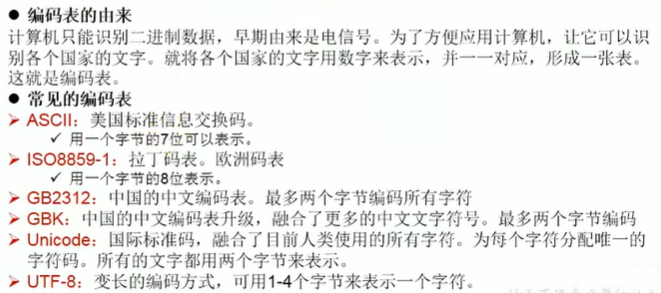
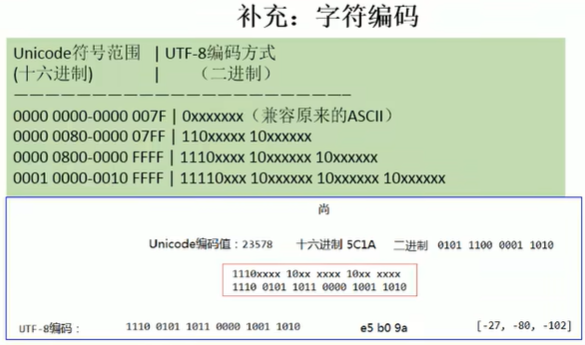

Convert stream to convert utf-8 format file to gbk format
//1.造文件、造流
File file1 = new File( pathname: "dbcp.txt");
File file2 = new File( pathname: "dbcp_gbk.txt");
FileInputStream fis = new FileInputStream(file1);
FileOutputStream fos = new FileOutputStream(file2);
InputStreamReader isr = new InputStreamReader(fis, charsetName: "utf-8");
OutputStreamWriter osw = new Outputstreamwriter(fos , charsetName: "gbk");
//2.读写过程
char[] cbuf = new char[20];
int len;
while((len = isr.read(cbuf)) != -1){
osw.write(cbuf, off: 0,len);
}
//3.关闭资源
isr.close();
osw.close();5. 标准输入、输出流(处理流)
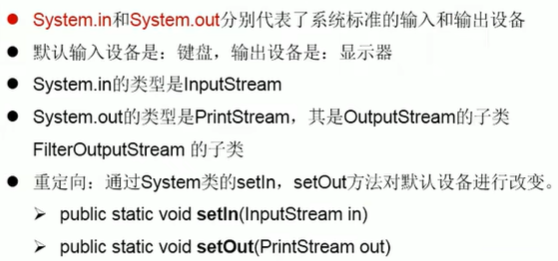
6. 打印流(处理流)
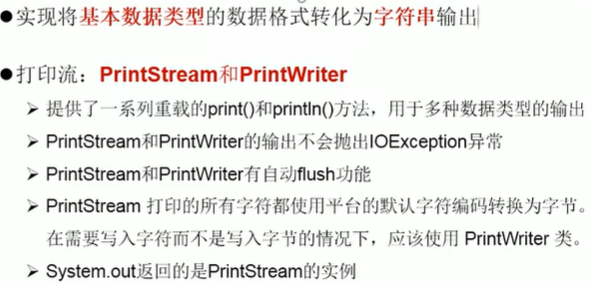
重新指定打印位置:打印字符到文件
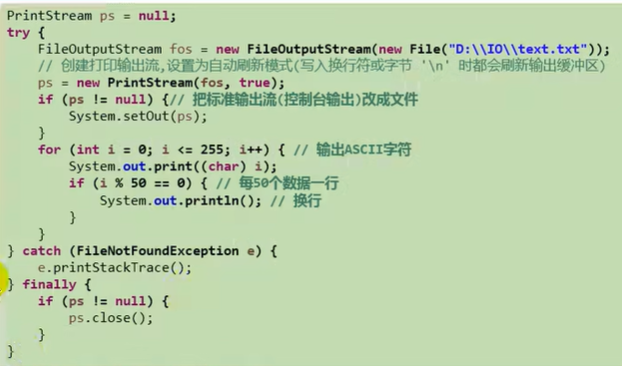
7. 数据流(处理流)
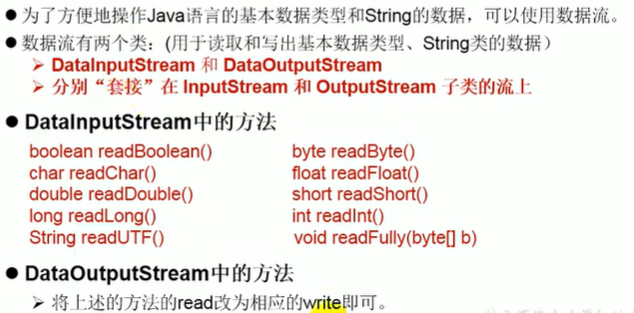
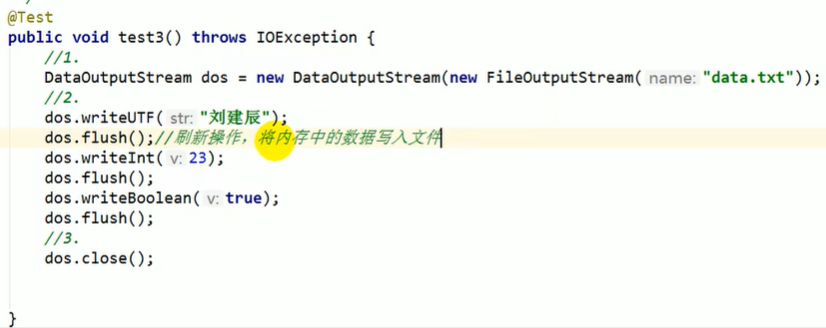

8. 对象流
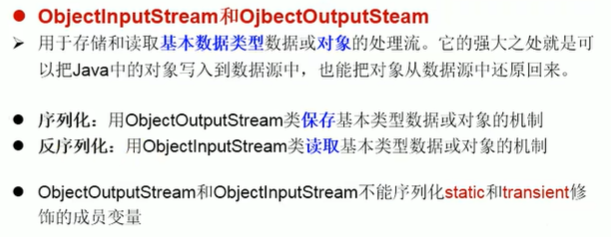
1.对象的序列化
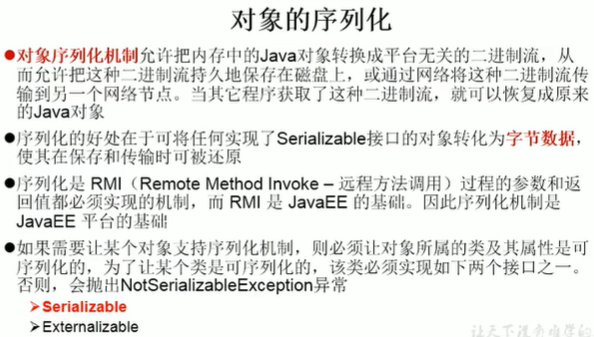
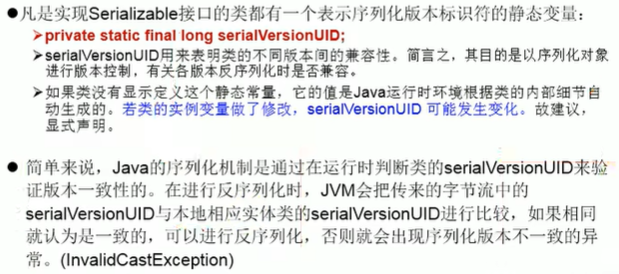
Person需要满足如下的要求,方可序列化
1.需要实现接口: Serializable
2.当前类提供一个全局常量: serialVersionUID
3.除了当前Person类需要实现Serializable接口之外,还必须保证其内部所有属性也必须是可序列化的。
public class Person implements Serializable {
public static final long serialVersionUID = 475463534532L;
private String name;
private int age;
private int id;
}对象的序列化操作
public void testObjectOutputStream() {
ObjectOutputStream oos = null;
try {
//1.
oos = new ObjectOutputStream(new FileOutputStream( name: "object.dat"))
//2.
oos.writeObject(new string( original:"我爱北京天安门"));
oos.flush();//刷新操作
oos.writeObject(new Persion(name: "张三",age: "23")));
oos.flush();//刷新操作
} catch (IOException e) {
e.printStackTrace();
}finally {
if(oos != null){
// 3.
try {
foos.close();
} catch(IOException e) {
e.printStackTrace();
}
}
}
}2.对象的反序列化:
将磁盘文件中的对象还原为内存中的一个java对象使用objectInputStream来实现
public void testobjecinputStream(){
ObjectInputStream ois = null;
try {
ois = new ObjectInputStream(new FileInputStream( name: "object.dat"));
Object obj = ois.readobject();
String str = (String) obj;
Person p = (Person) ois.readobject();
System.out.println(str);
System.out.println(p);
}
) catch (IOException e) {
e.printStackTrace();
}catch (ClassNotFoundException e) {
e.printStackTrace();
}注意:
ObjectOutputStream和ObjectlnputStream不能序列化static和transient修饰的成员变量
9. 随机存取文件流


RandomAccessFile的使用
1.RandomAccessFile直接继承于java.lang.Object类,实现了DataInputDataoutput接口
2.RandomAccessFile既可以作为一个输入流,又可以作为一个输出流
3.如果RandomAccessFile作为输出流时,写出到的文件如果不存在,则在执行过程中自动创建。如果写出到的文件存在,则会对原有文件内容进行覆盖。(默认情况下,从头覆盖)

四、NIO使用
